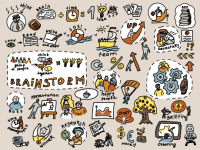“Mom, What is Project Management?”
Your content has been saved!
Go to My Saved Content.This question -- "Mom, what is project management?" -- was posed to me by one of my sons last year. It's a simple query, but crafting the answer to accommodate a child's lens of my career was a bit more challenging. So here was my response:
"It's the profession of planning, organizing and managing many things, including people and projects, for example."
A follow-up question by my other son within earshot was, naturally, "What's a project?"
OK, another fair question.
I explained to my sons that a project is, simply, a temporary and unique set of tasks that have a definite beginning and end -- a specific example being a book report.
Identifying the Constraints
The good news about project management is that, for teachers and students, it's already an intrinsic part of your everyday charter: planning a curriculum, organizing field trips, completing homework -- all of these basic tasks can be put under the umbrella of a project. Therefore, they are something that can be managed, and given the right tools and techniques, managed well.
There are six basic what we call "constraints" that need to be managed closely with a project, and they are scope, schedule, resources, budget, quality and risk. (I have incorporated these in the below example.) If you can keep all of these constraints in balance, then you will have a well-managed -- and therefore successful -- project.
So, now that we’ve covered some rudimentary project management definitions, how can you take these principles and apply them to your everyday life, and your students' as well?
Let's start by taking a specific real-world example, which I will walk you through step by step.
Sample Project: Student Book Report
1. Define the Project's Scope
This is the "what's involved?" in a project. In this example, it may be a book report on Martin Luther King, Jr. Additional requirements should be defined, such as length, delivery format, type of report, citation requirements, etc.
2. Establish a Schedule
This would be the timeframe of the project. When will you assign the report, when should the students start the report, and when should they have it completed? The students could also include interim dates for a first rough draft and a final draft.
3. Assign Your Resources
These are simply the people involved in the project. In this case, the resources would be teachers, students and maybe even parents if they are involved in the review process.
4. Budget (Assess Cost)
This details what would be involved in terms of assets the students (or you) may need to acquire. Will the student need to purchase reference books? Book report covers? Additional supplies?
5. Rate Quality
While this constraint is a bit more subjective, quality would consist not only of what you determine to be the standards by which you grade the report, but also a checklist that the student can generate to ensure he or she will turn in a high-quality report, such as:
- Do I have a topic sentence?
- Did I check for spelling and grammar?
- Is my report the proper length?
- Is my report neat and easy to read?
6. Determine Risk
What are the risk factors for this project? For a student, it can be anything from competing priorities in getting the book report done, to a possible tendency to procrastinate. Risks are any "future" potential problem that may interfere with getting the book report project done on time, done on schedule and done well -- the basic triad of concerns for every project manager!
It is important to note that project management is also key to ensuring success with project-based learning initiatives in your classroom. By leveraging project management's core standards and principles, you can dramatically increase the success of your initiatives, no matter what stage or phase they may currently be in.
The book report is just one example of a project. How do you apply project management skills in your classroom?
